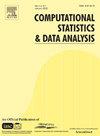Spline regression with automatic knot selection
IF 1.5
3区 数学
Q3 COMPUTER SCIENCE, INTERDISCIPLINARY APPLICATIONS
引用次数: 0
Abstract
Spline regression has proven to be a useful tool for nonparametric regression. The flexibility of this function family is based on basepoints defining shifts in the behavior of the function – called knots. The question of setting the adequate number of knots and their placement is usually overcome by penalizing over the spline's overall smoothness (e.g. P-splines). However, there are areas of application where finding the best knot placement is of interest. A new method is introduced for automatically selecting knots in spline regression. The approach consists in setting many initial knots and fitting the spline regression through a penalized likelihood procedure called adaptive ridge, which discards the least relevant knots. The method – called A-splines, for adaptive splines – compares favorably with other knot selection methods: it runs way faster (∼10 to ∼400 faster) than comparable methods and has close to equal predictive performance. A-splines are applied to both simulated and real datasets.
带有自动结点选择功能的样条回归
事实证明,样条回归是一种有用的非参数回归工具。该函数系列的灵活性基于定义函数行为偏移的基点(称为节点)。通常通过对样条曲线的整体平滑度进行惩罚(如 P 样条曲线)来解决设置足够数量的节点及其位置的问题。然而,在某些应用领域中,寻找最佳的节点位置也很重要。本文介绍了一种在样条回归中自动选择节点的新方法。该方法包括设置许多初始节点,并通过一种称为自适应脊的惩罚似然程序拟合样条回归,从而舍弃最不相关的节点。这种方法被称为 A-splines(自适应样条曲线),与其他节点选择方法相比,它的运行速度更快(10 到 400 倍),预测性能也接近相同。A 样条法同时适用于模拟数据集和真实数据集。
本文章由计算机程序翻译,如有差异,请以英文原文为准。
求助全文
约1分钟内获得全文
求助全文
来源期刊

Computational Statistics & Data Analysis
数学-计算机:跨学科应用
CiteScore
3.70
自引率
5.60%
发文量
167
审稿时长
60 days
期刊介绍:
Computational Statistics and Data Analysis (CSDA), an Official Publication of the network Computational and Methodological Statistics (CMStatistics) and of the International Association for Statistical Computing (IASC), is an international journal dedicated to the dissemination of methodological research and applications in the areas of computational statistics and data analysis. The journal consists of four refereed sections which are divided into the following subject areas:
I) Computational Statistics - Manuscripts dealing with: 1) the explicit impact of computers on statistical methodology (e.g., Bayesian computing, bioinformatics,computer graphics, computer intensive inferential methods, data exploration, data mining, expert systems, heuristics, knowledge based systems, machine learning, neural networks, numerical and optimization methods, parallel computing, statistical databases, statistical systems), and 2) the development, evaluation and validation of statistical software and algorithms. Software and algorithms can be submitted with manuscripts and will be stored together with the online article.
II) Statistical Methodology for Data Analysis - Manuscripts dealing with novel and original data analytical strategies and methodologies applied in biostatistics (design and analytic methods for clinical trials, epidemiological studies, statistical genetics, or genetic/environmental interactions), chemometrics, classification, data exploration, density estimation, design of experiments, environmetrics, education, image analysis, marketing, model free data exploration, pattern recognition, psychometrics, statistical physics, image processing, robust procedures.
[...]
III) Special Applications - [...]
IV) Annals of Statistical Data Science [...]
 求助内容:
求助内容: 应助结果提醒方式:
应助结果提醒方式:


